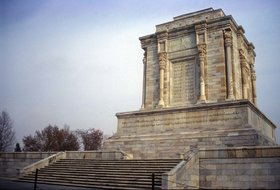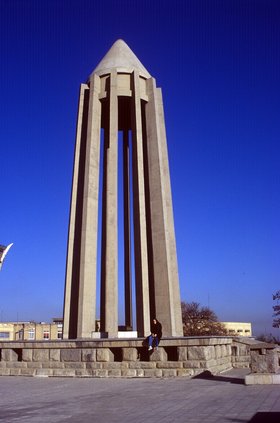Essays
Talinn Grigor, Building Iran
Modernism, Architecture, and National Heritage under the Pahlavi Monarchs
Building Iran: Modernism, Architecture, and National Heritage is a remarkable account of Iranian modern history. Architecture played a crucial part in this history: it was a major political tool in re-appropriating Iranian cultural heritage alongside secular reforms during the Pahlavi monarchic rule of Reza Shah (1925-41) and his son Mohammad Reza Shah (1941-79). The book highlights the pivotal role played by the Society for National Heritage (SNH), established in 1922, in executing a major modernist architectural overhaul in Iran. The SNH was responsible for commissioning various monuments and buildings throughout Iran, which included mausoleum style tombs for Iran's treasured poets such as Ferdowsi, Hafez and Omar Khayam, the first archaeology museum and first national library, as well as various architectural preservation projects. The aim of this utopian and large-scale architectural facelift was to fast-track Iran into the twentieth century. It embraced Iran's epic cultural history as well as its penchant for progressiveness by adopting Aryan modernist principles.
In Building Iran, Talinn Grigor makes explicit the knowledge and history that has so far remained only amongst privileged circles, and deconstructs Iran's complex architectural history through a close analysis of its reconstructed monuments. She (re)evaluates how the Pahlavi's zeal for modernization and the SNH's projects attempted to deconstruct monumentality by rebuilding pre-existing architectural sites and erecting new monuments on which to project utopian ideologies and secular traditions. The movement to entice the masses away from religion towards civil pilgrimage was an important goal of the Pahlavi's and SNH's missions, and Grigor highlights that this was achieved by looking back at Iran's glorious pre-Islamic era.
An important example is the designing of the mausoleum of Ferdowsi, the poet and author of the tenth-century national epic, the Shahnameh (book of kings in Farsi), to celebrate Ferdowsi's millenary anniversary in 1934. The building functions as a booster of national pride based on the Shahnameh's representation of ancient Iran. Ferdowsi's tomb was initially designed by French architect and archaeologist André Godard (1924-34) in Tus and became known as Ferdowsiyeh with its distinctive pre-Islamic design and Zoroastrian ornamentation. Ferdowsiyeh contributed to fabricating a sense of modernism by becoming a touristic site, where Iranian families performed modern past-times such as picnicking and taking day trips. Grigor points out that it was plagued with several design problems; that it was already sinking into the ground in 1934 and was considered a symptomatic example of Reza Shah's hasty desire for rapid reform. Yet Ferdowsiyeh took 43 years to fully complete, with Iranian architect Houshang Seyhoun finishing its design in 1968. It came to represent – somewhat paradoxically – Reza Shah's invented history. However, unlike the case of Ferdowsiyeh other projects conducted under the auspices of the SNH were more efficient as Grigor meticulously details.
Although Building Iran takes a critical stance towards the tenure of the Pahlavi era it does offer a particularly rewarding chapter, Masculinist Myths of Modernism, which analyses how the power shifted organically from the Shah and the SNH during the 1970s to the queen. Farah is represented as an admirable model, who established several cultural centres and chaired all national and international cultural and arts related affairs. Within the chapter, Grigor interweaves Farah's story alongside an analysis of American born art historian and Persian art expert Phyllis Ackerman. Ackerman's husband was Arthur Pope, an acclaimed historian, professor and consultant to Mohammed Reza on Persian art – his legacy, like that of Reza's, was largely upheld by his wife. Grigor portrays both Farah and Phyllis as highly feminist figures, the real 'architects' who shaped art and society, as Grigor states, 'through the agency of 'mere art', Queen Farah in politics, and Ackerman, in academia, exercised power over their respective mainstreams. While Farah and Ackerman could not (and would not) prevent a revolution, they did question and exasperate the masculinist strictures of culture, modernity, and politics that defined the Iran of the 1970s.'
While Building Iran is largely a study of twentieth-century architectural history it does give an inadvertent clue to Iran's twenty-first-century future, coded within the cover art, which pictures a defiant scene from the 2009 election protests. The image features hundreds of protestors in Tehran with the city's famous Shayad Aryamehr monument dominating the landscape, a building designed by Hosayn Amanat (1971-74) to mark the 2,500th anniversary of the Persian Empire and renamed Azadi (freedom in Farsi) in 1979 after the Iranian Revolution. The choice of this epic vista suggests that the future history lies in next generation of Iranians – these 'informal architects' who have spurned a global outcry are at the cusp of becoming the rightful custodians in (re)building Iran.







